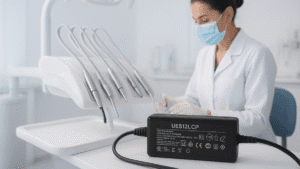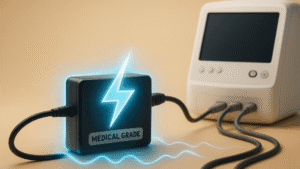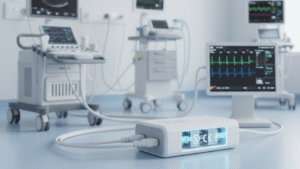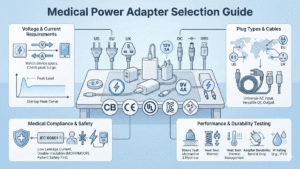Introduction
The pet technology market has entered a period of unprecedented growth. Among the devices that have transformed daily pet care, smart pet feeders stand out as both convenient and essential. These devices allow pet owners to manage feeding schedules remotely, track consumption, and even monitor pets through integrated cameras. For many owners, a smart feeder represents peace of mind and a bridge between human schedules and animal needs.
Yet, beneath the sleek design and sophisticated software lies an unsung hero: the power adapter. While consumers rarely think about it, the adapter is the very foundation upon which the reliability of the feeder depends. If the adapter fails or underperforms, the entire user experience collapses—potentially leaving pets unfed and owners frustrated.
This article explores in depth the relationship between smart pet feeders and their power adapters. We will analyze how the adapter affects device stability, safety, energy efficiency, and long-term usability. Furthermore, we will uncover why manufacturers must give this “invisible component” the attention it deserves.
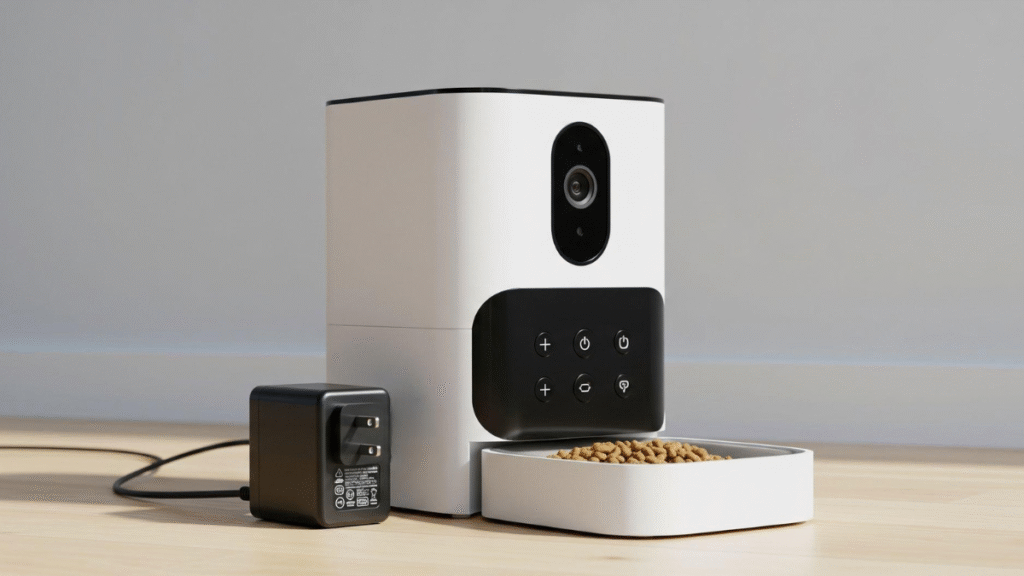
The Rise of Smart Pet Feeders
A Growing Market
The global pet technology market has been on a steady upward trajectory. In 2023, it was valued at nearly $7 billion, and forecasts suggest it may exceed $20 billion by 2030. Within this ecosystem, smart feeders are among the fastest-growing product categories, largely because they directly address an everyday need: ensuring pets are fed reliably and consistently.
Drivers of Adoption
Several factors have fueled the growth of smart feeders:
- Urban lifestyles: Busy professionals and long working hours create demand for automated feeding.
- Pet humanization: Pets are increasingly viewed as family members, pushing owners to invest in smarter care.
- IoT integration: Smart feeders often integrate with mobile apps, smart home systems, and even voice assistants.
- Data-driven care: Modern feeders log feeding schedules, portions, and even detect irregular eating habits.
While features differ across models, nearly all feeders share one requirement: they must operate continuously, without interruption. And this requirement ties directly to the quality of the power adapter.
Anatomy of a Smart Pet Feeder
A typical smart feeder contains several subsystems:
- Motor and dispensing system – Responsible for delivering precise portions.
- Control board and Wi-Fi module – Handles remote connectivity and user commands.
- Camera and microphone (in premium models) – Allows real-time monitoring and interaction.
- Sensors – Detect food levels, bowl presence, and mechanical blockages.
- User interface – Touchscreen or LED panel for direct control.
- Power supply – Ensures that all components receive stable voltage and current.
Without a stable adapter, these subsystems fail to coordinate properly. For instance:
- The motor may jam without sufficient current.
- The Wi-Fi module may reset under voltage fluctuations.
- The camera may lag or shut down if power is unstable.
In short, the power adapter determines whether the feeder is functional, reliable, and trustworthy.
Power Adapters: The Invisible Backbone
What is a Power Adapter?
A power adapter converts high-voltage AC (Alternating Current) from a household outlet into low-voltage DC (Direct Current) suitable for electronics. For smart feeders, common ratings include DC 5V/2A or DC 12V/1.5A, though exact requirements vary.
Key Roles
- Voltage regulation: Prevents overvoltage or undervoltage that could damage sensitive chips.
- Current supply: Ensures sufficient current for motor operation and camera streaming.
- Safety protection: Includes safeguards against short circuits, overheating, and surges.
- Energy efficiency: Reduces standby power draw and environmental footprint.
The quality of a power adapter can make the difference between a flawless user experience and a cascade of frustrating malfunctions.
User Experience Case Studies
Case 1: The Interrupted Feeding
A pet owner in New York reported that their smart feeder randomly stopped dispensing food. After troubleshooting, it was revealed that the bundled adapter could not sustain current during motor activation. Replacing it with a certified adapter solved the issue immediately.
Case 2: Connectivity Nightmares
A household in Tokyo struggled with repeated Wi-Fi disconnections. The feeder appeared faulty, but technicians discovered the adapter’s unstable voltage was resetting the Wi-Fi module multiple times a day. A higher-quality adapter restored stable connectivity.
Case 3: Video Streaming Failures
Owners of high-end feeders with cameras often complain about laggy or frozen video. In many cases, the culprit is insufficient power from low-grade adapters, which causes the camera system to underperform.
These examples highlight a key truth: users often blame the device, when in reality the adapter is at fault.
Risks of Poor-Quality Power Adapters
1. Device Malfunction
Cheap adapters may fail to deliver rated output, leading to unreliable operation.
2. Safety Hazards
Poor insulation, lack of certifications, or substandard materials can lead to overheating, electrical fires, or shocks.
3. Shortened Device Lifespan
Power fluctuations accelerate component wear, particularly on control boards and motors.
4. Negative Brand Perception
When users experience problems, they blame the device manufacturer, not the anonymous adapter supplier. This erodes trust and damages brand reputation.
5. Environmental Impact
Low-efficiency adapters waste energy, contributing to unnecessary carbon emissions.
Compliance and Safety Standards
Common Certifications
- UL (United States)
- CE (Europe)
- FCC (United States, for electromagnetic interference)
- CCC (China)
- PSE (Japan)
- KC (Korea)
Energy Efficiency
Many countries require compliance with standards like DOE Level VI or ErP Lot 7, which set limits on no-load power consumption.
Testing Protocols
Adapters must pass tests for:
- Overvoltage protection
- Short-circuit endurance
- Thermal management
- Long-term stability
Compliance ensures that not only pets remain safe, but also households are protected from electrical hazards.
Future of Power Adapters in Pet Tech
GaN (Gallium Nitride) Technology
GaN adapters are smaller, cooler, and more efficient than traditional silicon adapters. They represent the future of compact, high-performance power solutions.
USB-C and Power Delivery (PD)
As more devices adopt USB-C PD protocols, smart feeders may shift toward standardized, interchangeable power systems.
Intelligent Power Management
Smart adapters may soon monitor device load and optimize power delivery in real time, improving both efficiency and reliability.
Eco-Friendly Design
Recyclable materials, reduced standby consumption, and modular designs for different plug standards are likely to dominate the next generation of adapters.
Conclusion
Smart pet feeders have become indispensable tools for modern pet owners. However, the convenience and reliability they promise are only possible when supported by a robust, efficient, and safe power adapter. While consumers may never think twice about the adapter, manufacturers must recognize its central role in shaping user experience, device longevity, and brand reputation.
The future of pet technology will undoubtedly bring more advanced feeders, smarter features, and deeper integration with connected homes. But none of these innovations will succeed without the silent yet vital backbone: the power adapter.

